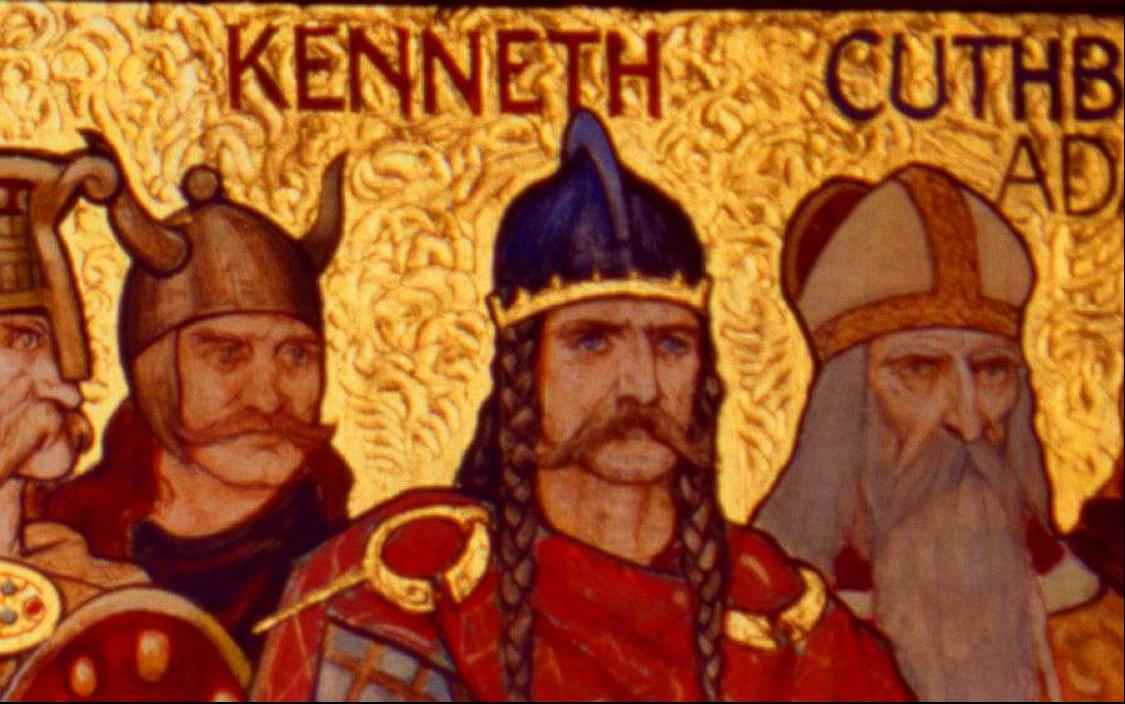The Rise of Kenneth MacAlpin
Scotland Before Kenneth’s Rule
Before the reign of Kenneth MacAlpin, the land that would become Scotland was divided between two main groups: the Gaels of Dal Riata in the west and the Picts, who controlled much of the north and east. The Gaels, of Irish origin, brought their language, traditions, and Christian influence, while the Picts were an ancient people with their own unique culture, known for their intricate stone carvings and warrior society.
Kenneth’s Origins and Early Life
Kenneth MacAlpin, also known as Cináed mac Ailpín, was born around 810 AD. He was originally a ruler of Dal Riata, inheriting leadership at a time when the kingdom faced constant threats from Viking raids and internal conflicts. The Picts, too, were under pressure, both from Viking invaders and internal struggles for power.
The Unification of the Gaels and Picts
Around 843 AD, Kenneth became the first king to rule both the Gaels and the Picts, forming the early Kingdom of Scotland, called Alba. How he achieved this remains uncertain. Some historians suggest he gained power through military conquest, while others believe strategic marriages and alliances played a role. His rise may have also been helped by external threats, such as Viking raids, which weakened the Pictish leadership and created an opportunity for unification.

MacAlpin’s Treason: Myth or Reality?
The Legend of the Treacherous Feast
One of the most famous stories about Kenneth’s rise to power is the legend of “MacAlpin’s Treason.” According to this tale, Kenneth invited Pictish nobles to a grand feast, only to betray and kill them, securing his rule over the Pictish lands. This dramatic story has been passed down for centuries, portraying Kenneth as a ruthless but effective leader.
Historical Debate and Doubts
While the story of MacAlpin’s Treason is well-known, historians debate its authenticity. Some believe it was later propaganda to justify his rule over the Picts, while others argue it might be based on real events, exaggerated over time. What is clear is that Kenneth successfully united two distinct cultures, whether through force or diplomacy.
The Impact of the Unification
Regardless of how he achieved it, Kenneth’s rule marked a turning point in Scottish history. By merging Gaelic and Pictish traditions, he laid the groundwork for the Kingdom of Alba, which would eventually evolve into Scotland. His leadership set a precedent for future kings, who continued to strengthen and expand the kingdom.
Kenneth’s Reign and Lasting Legacy
Governance and Challenges
Kenneth ruled until his death in 858 AD, likely at Forteviot, a royal center in modern-day Perthshire. His reign was marked by continued struggles against Viking incursions, a challenge that would persist for generations. Despite these threats, he managed to consolidate his rule and establish a stable foundation for future Scottish monarchs.
Merging Two Cultures
Under Kenneth’s rule, Gaelic traditions became more dominant, but elements of Pictish culture persisted. The Gaelic language began to spread, influencing the future identity of Scotland. Religious and artistic traditions from both groups blended, shaping early medieval Scottish culture.
The MacAlpin Dynasty
Kenneth’s descendants played a crucial role in shaping Scotland. His sons and later generations ruled Alba, continuing the unification process and expanding Scottish influence. The kingdom he founded would eventually become the Scotland we know today, with a rich heritage rooted in both Gaelic and Pictish ancestry.
The Enduring Influence of Kenneth MacAlpin
Kenneth in Scottish History and Mythology
Kenneth MacAlpin remains a legendary figure in Scottish history, often regarded as the founder of Scotland. His story, whether historical or mythological, symbolizes the unification of different peoples under a single rule, a theme that has resonated throughout Scottish history.
His Impact on the Scottish Monarchy
Many of Scotland’s later kings traced their lineage back to Kenneth, solidifying his place as the first true king of Scotland. His leadership established a legacy of unity, resilience, and adaptation that defined Scotland’s monarchy for centuries.
Modern Recognition
Today, Kenneth MacAlpin is remembered as a foundational figure in Scottish history. His contributions are studied by historians, and his legacy is honored in various historical sites across Scotland. The blending of Gaelic and Pictish traditions under his rule continues to shape Scottish culture and identity.
Conclusion: Kenneth MacAlpin’s Lasting Legacy
Kenneth MacAlpin’s reign was a turning point in Scottish history, bringing together two distinct cultures to form a unified kingdom. Whether through strategy, warfare, or diplomacy, he succeeded in laying the foundation for Scotland’s future. His legacy lives on in the traditions, language, and identity of Scotland, making him one of the most significant figures in its early history
